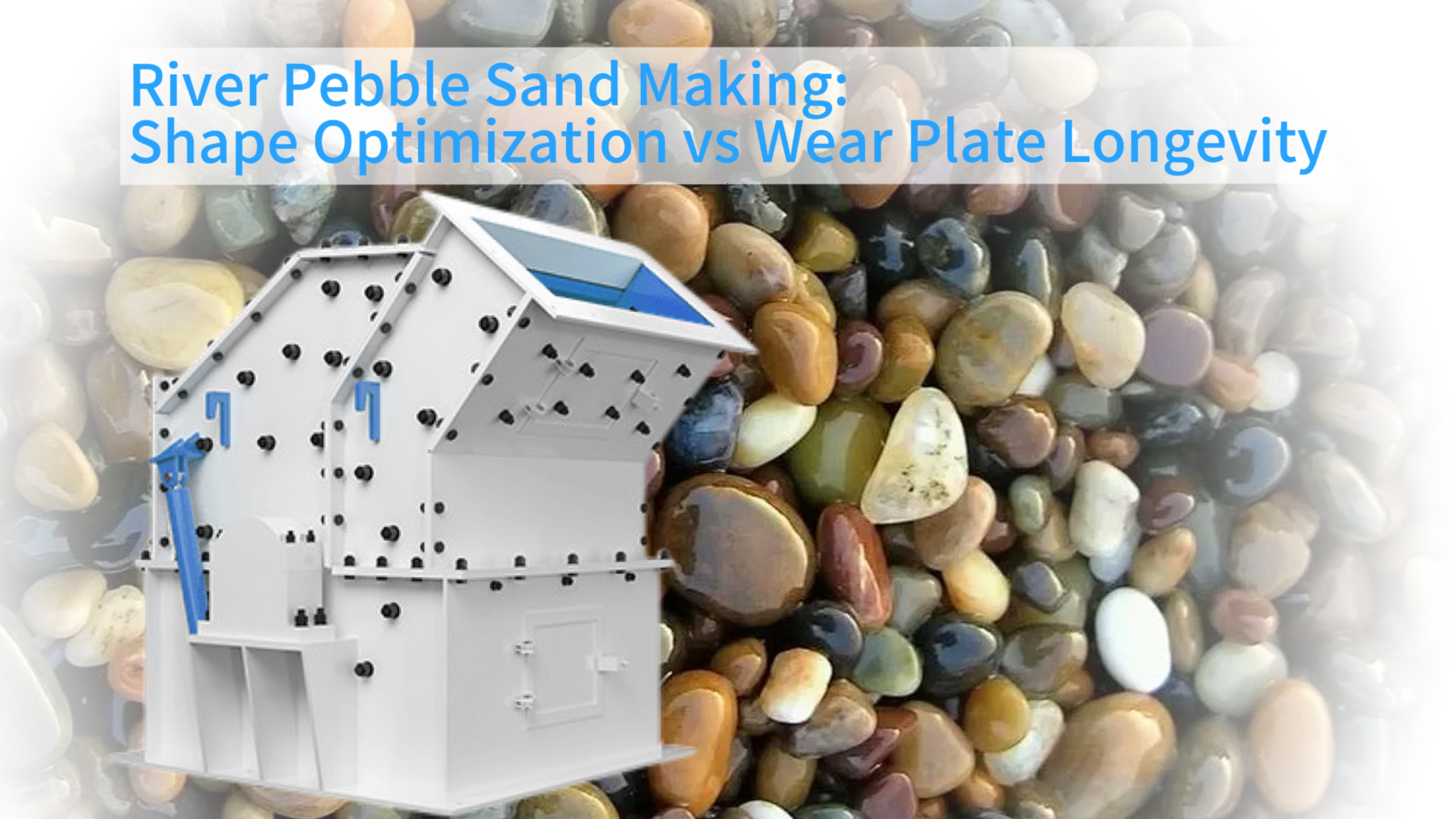River Pebble Sand Making: Shape Optimization vs Wear Plate Longevity

Producing high-quality sand from river pebbles requires balancing particle shape optimization with equipment durability in fine crusher operations. This guide examines how sand producers achieve superior grain geometry while maximizing wear plate lifespan. We'll explore the relationship between crushing chamber design, material selection, operational parameters, and maintenance strategies, providing practical solutions for aggregate production facilities seeking to optimize both product quality and equipment longevity.
Particle Shape Optimization Techniques
Superior sand particle shape directly influences concrete workability and structural integrity. In vertical shaft impact crushers, the rotor's throwing angle determines impact velocity and collision patterns. Optimal projection angles between 45-60 degrees create multiple rock-on-rock impacts, naturally rounding particles without excessive fragmentation. Material trajectory simulations reveal how controlled collision paths produce cubical grains ideal for construction applications.
Grading adjustments significantly affect particle distribution curves. Closed-loop systems with integrated screening allow continuous particle shape refinement through recirculation. Different pebble types require customized approaches - granite produces more angular fragments than limestone, demanding specific crushing chamber geometries in fine crushing operations.
Impact Crusher Geometry Principles
Rotor configurations determine impact patterns that transform angular pebbles into rounded sand particles.
Material Trajectory Modeling
Computer simulations optimize crushing chamber designs for maximum particle-on-particle collisions.
Closed-Loop Particle Refinement
Recirculation systems enable multiple processing stages for improved grain shape consistency.
Geological Variation Considerations
Different mineral compositions require customized processing parameters in fine crushing applications.
Wear Plate Degradation Mechanisms
River pebbles present exceptional wear challenges to fine crushers due to their quartz content. High-velocity impacts create micro-fractures in wear plates, while fine silt particles accelerate surface erosion through three-body abrasion. Material selection becomes critical - high-chromium cast iron provides impact resistance, while ceramic composites offer superior surface hardness against abrasion.
Thermal stresses present another degradation factor. Repeated impact zones develop localized heating that promotes thermal fatigue cracking. Finite element analysis helps engineers identify high-stress areas for reinforcement. Real-time thickness monitoring systems track wear progression, allowing operators to predict replacement timing and avoid unexpected failures.
Finite Element Stress Analysis
Computer modeling identifies high-impact zones needing reinforced material composition.
Surface Hardening Technologies
Thermal treatments extend service life by 30-50% in abrasive fine crushing environments.
Lifecycle Cost Calculations
Thickness-to-replacement interval ratios determine economical maintenance schedules.
Real-Time Wear Monitoring
Ultrasonic sensors track thickness loss without disrupting production processes.
Operational Parameter Optimization
Rotor speed directly influences both particle shape and wear rates in fine crushers. Higher velocities improve particle rounding but exponentially increase wear plate degradation. The optimal range of 55-65 m/s balances these competing factors. Feed size distribution presents another critical variable - mixtures exceeding 15% oversize material cause uneven feed distribution and accelerated localized wear.
Discharge gap settings create a precise balancing function. Narrow gaps improve particle shape but increase pressure on wear components. Advanced dust control systems reduce abrasive particles in the crushing environment, while intelligent lubrication systems maintain optimal bearing temperatures to prevent thermal degradation.
Variable Frequency Drive Applications
Precise rotor speed adjustments accommodate changing material characteristics.
Feed Uniformity Management
Vibrating feeders ensure consistent material flow to prevent component stress.
Dust Suppression Systems
Negative pressure environments reduce abrasive particle recirculation.
Thermal Regulation Strategies
Intelligent lubrication maintains optimal operating temperatures during extended runs.
Synergistic Maintenance Approaches
Proactive maintenance strategies synchronize particle quality monitoring with component health assessment in fine crushing operations. Wear plate tension adjustments maintain consistent impact surfaces, while particle shape analysis data triggers preemptive liner replacements. Inventory management systems incorporate predictive algorithms to ensure critical spares availability.
Production planning integrates maintenance schedules to minimize operational disruptions. Component rotation strategies extend usable life - symmetrical wear plates can be repositioned to utilize unworn surfaces. Third-party wear analysis provides unbiased component assessments, while seasonal adjustments account for temperature-driven material property changes.
Predictive Maintenance Implementation
Vibration analysis detects developing issues during normal operations.
Component Rotation Economics
Strategic repositioning extends wear plate utilization before replacement.
Environmental Adaptation Protocols
Seasonal maintenance adjustments maintain consistent processing conditions.
Independent Wear Assessment
Third-party analysis provides unbiased component evaluations.
Application-Specific Solutions
Different construction applications demand specialized approaches in fine crushing. High-grade concrete production prioritizes perfect particle geometry, accepting higher wear component costs. Hydraulic engineering projects emphasize maximum equipment durability to withstand continuous processing. Mobile installations balance portability requirements with sufficient component robustness.
Environmental factors significantly influence parameter optimization. Freezing temperatures require material pre-heating systems, while mobile VSI units incorporate magnetic separation for contaminated deposits. Staged crushing processes progressively refine particle shapes with minimal wear impact.
Moisture Management Techniques
Anti-adhesion coatings prevent clogging in humid fine crushing conditions.
Metallic Contaminant Removal
Integrated magnetic separators protect crushing components from metal damage.
Multi-Stage Crushing Benefits
Tandem processing systems progressively refine particle geometry.
Integrated Production Optimization
Automated resource allocation balances multiple product specifications.
Selection Framework and Validation
Equipment selection requires multi-criteria decision models for fine crushers. Lifecycle cost analysis must quantify both quality premiums from superior particle shapes and savings from extended component longevity. Industry certification standards provide objective benchmarks for validating manufacturer performance claims.
Practical verification remains essential. On-site pilot testing generates reliable performance data. Digital twin simulations predict long-term operational outcomes. Collaborative partnerships enable continuous parameter refinement based on operational feedback.
Parameter Weighting Methodology
Decision matrices balance particle quality against operational cost considerations.
Lifecycle Cost Quantification
Comprehensive accounting includes quality premiums and maintenance costs.
Performance Validation Testing
On-site trials provide reliable operational data for final decisions.
Digital Simulation Applications
Virtual modeling predicts long-term outcomes of different configurations.